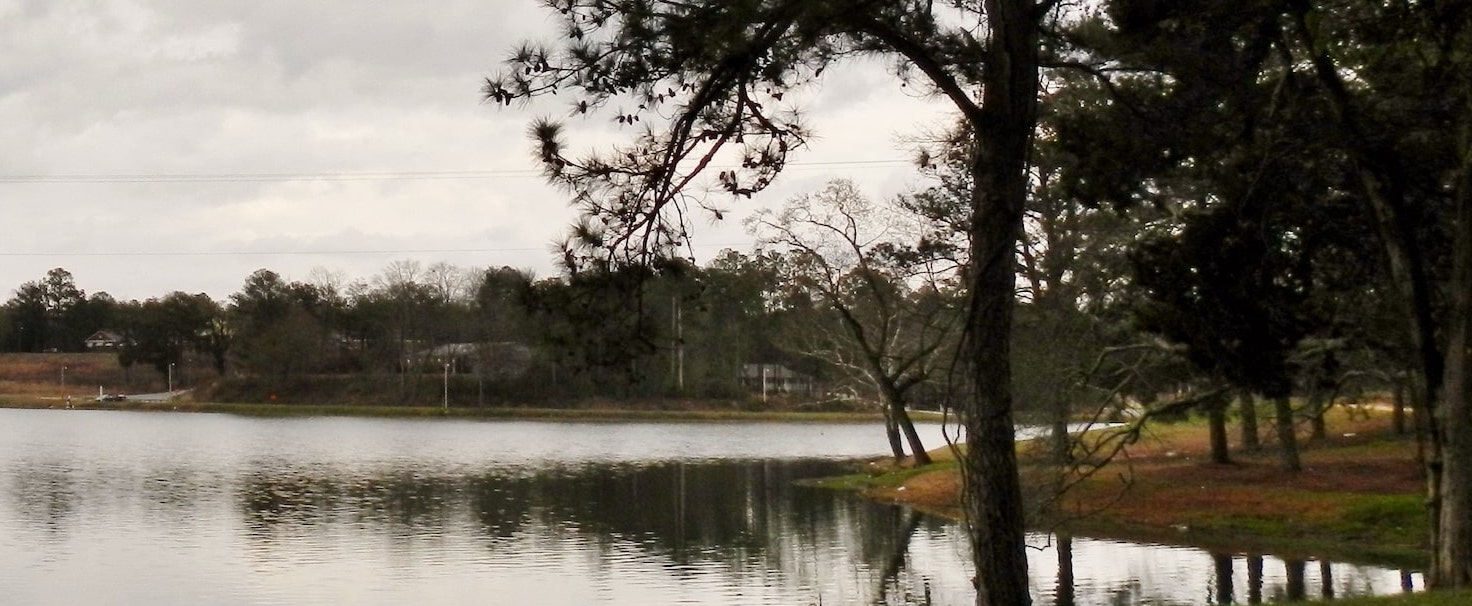
Tuskegee’s Jesup Cyber Wagon:
Revisiting a Groundbreaking
Idea to Tackle Historic Inequalities
More than 100 years ago, George Washington Carver saw inequity in farming in the rural areas in Alabama, in the southeast United States. Resources were scarce, but Washington saw a deeper problem.
Many Black rural farmers were tied to their land, unable to travel to learn new farming techniques or attend practical demonstrations. Without the ability to keep up with modern agricultural practices, a gap could grow, with the farmers no longer able to sustain themselves.
With this problem in mind, Carver, a professor and head of the Department of Agriculture at the Tuskegee Institute, designed the Jesup Agricultural Wagon: a mule-drawn “moveable school” that brought agricultural education to Black rural farmers. It came equipped with tools to harvest the land, like plows, fertilizers, and seeds, as well as demonstration items like plants and soil samples. Within its first few months of operation, the Jesup Wagon was able to reach more than 2,000 people per month.
Carver, who had been born into slavery during the last years of the Civil War, knew well the opportunities education could bring, and the barriers many Black communities faced to learning and accessing new technologies. It’s an inequity that persists today, over a century later.
The Jesup Cyber Wagon
Modern Internet can feel like a given in the United States, but areas that have traditionally been bereft of resources and federal, state, and regional support are often left in the cyber dark, even in the 21st century. So where traditional solutions fail to meet people’s challenges, a local entrepreneur is bringing Internet connectivity to his community through a community network.
Boyd Stephens is a network operator for Netelysis. He also spearheaded the Jesup Cyber Wagon Community Network. It all started when he stumbled upon the Expanding Potential in Communities (EPIC) Grant by the Internet Society and Truist Financial. He wasn’t looking for an extra project, and almost passed it by, but Stephens saw it as an opportunity to address the connectivity challenges Black communities were facing in Tuskegee.
“One day, I’m perusing some of my favorite websites, and I see this Truist opportunity. I read down into the minutia and I say, ‘shucks this has our name written right on it, this is what we live, sleep, dream, and exist for professionally,’” Stephens says.
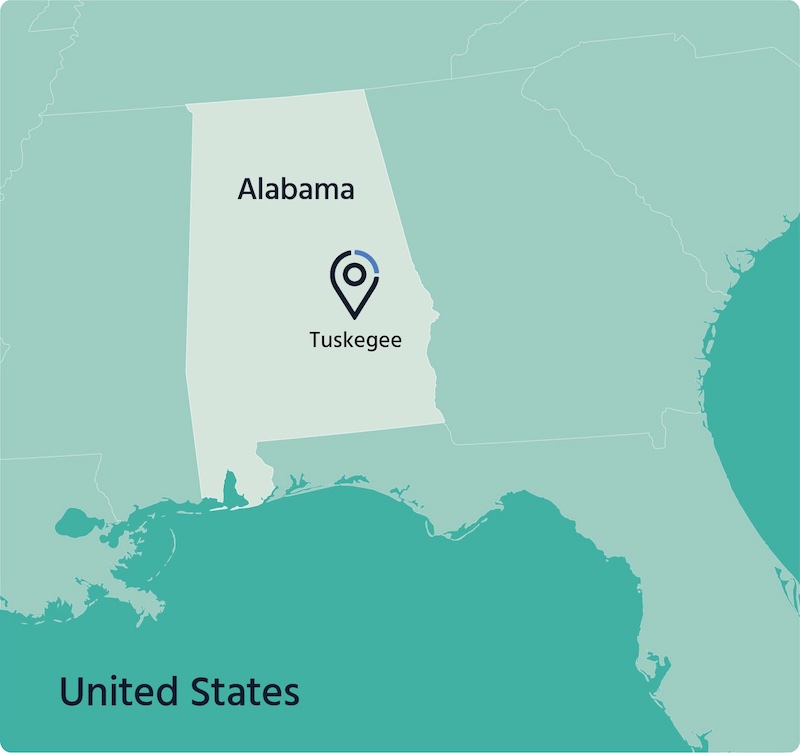
The compelling drive is to empower people, both economically and socially to give them a voice. Because no one can tell your story the way you can tell your story, and this wonderful network of networks, the Internet, allows you to do a pretty good job of that.”
“The whole purpose of the [original] Jesup Wagon was to take that science that happened at the university and a little wagon would go around the Black belt and train farmers in the latest concepts of agriculture,” says Stephens. “We’re kind of leveraging that imagery of saying let’s now take that Jesup Wagon concept and wrap it around something in the cyber realm.”
Jesup Cyber Wagon was created to build and maintain a community network to provide Internet access in Tuskegee and the surrounding areas, through the Housing Authority, an agency that provides affordable housing to the local communities. But the community network’s work doesn’t stop there. Stephens’s presence on the ground allows for continuing soft skill training so that the local community can sustain the network, improve it, and use it to benefit their community on a holistic scale.
“The compelling drive is to empower people, both economically and socially to give them a voice. Because no one can tell your story the way you can tell your story, and this wonderful network of networks, the Internet, allows you to do a pretty good job of that,” Stephens says.
A man standing on a ladder installing Internet hardware.
A Vital Partnership
The Jesup Cyber Wagon project was supported by the Internet Society through a partnership with Truist Financial. Through the Expanding Potential in Communities (EPIC) Grant program, a total of $1 million USD was awarded to five communities in 2021 in the southeastern region of the United States—so they could build and manage their own Internet networks, on their own terms.
“The Internet Society has long had a goal to make sure that Internet is for everyone, and those who want it can get it,” says the Internet Society’s Senior Director for North American Government and Regulatory Affairs, Natalie Campbell. “With Truist, we can support efforts to bring Internet to rural surroundings through community networks.”
Tuskegee received nearly $180,000 USD from the grant to improve their infrastructure, and Stephens ran with it.
Building the Network
Boyd Stephens’ first goal was to get the community network up and running so that the people served by the Tuskegee Housing Authority could access the Internet. With the funding of Truist, the resources of the Internet Society, and the expertise of locals like Stephens, Jesup Cyber Wagon achieved this within a year.
The deployment includes an after-school training and tutorial facility, plus a technical training facility, both of which have 10 gigabit Internet running to them.
“It’s a full-fledged community network with fiber. Historically, we would manage it after the Telco (telecommunications company) hands the connection off, but here we had to go through the whole thing: dealing with public utilities, digging fiber, making sure we didn’t clip lines, and the like,” Stephens says. “We’ve studied the community network arena and saw some challenges. For instance, too often people get enamored with the technology. But you have to be inclusive, bring people in, and let them have a say.”
A community network is more than just the physical infrastructure. Once built, the people within the community need to know how to use it, how to sustain and fix it, and how to advance it.
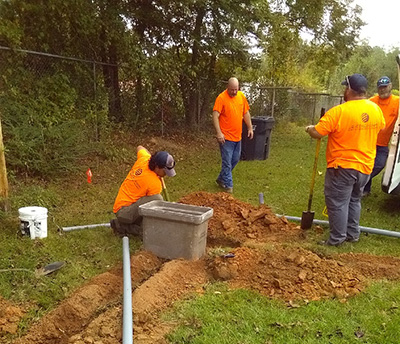
Team from the Lek Technology Group digging trenches to lay fiber cables.
Sustainable Internet Connectivity
“If you train a subset of the community on how to repair, now all you have to do is keep the community network up. The network becomes self-serving,” Stephens says. “That same community network then becomes the training ground. You’ll need a call center. With it, we are able to teach people those soft skills. As they service these call centers they become proficient and can transfer to other call centers for employment—and with the community network, they can work from home.”
Now Stephens is looking for the people living in Tuskegee to become long-term ambassadors of this technology. Eventually, the hope is to train local residents to support the network, itself another form of career development and training.
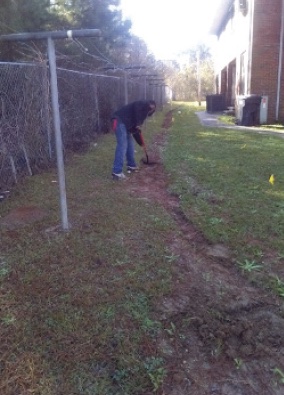
Behind the Housing Authority’s Community Residence, Tony, who lives in one of the residence’s apartments, buries the fiber cables.
“If you’re providing support in your affordable housing community, and you’re trained in user support, there’s no difference between doing it there and doing it for the state of Alabama, or for Hyundai,” Stephens says. “You’re getting experience, so when you apply for a job as a support technician, your experience is just as legitimate as anyone else’s.”
Jesup Cyber Wagon is doing early outreach to find and develop local talent. Through a mentoring training program, it brings in high school students to train them on computing and the philosophical areas of technology. The hope is that the training will lead to a career in technology.
Stephens has taken hard assets—a community network and facilities erected through grant money—and instilled within that structure soft skill training to bring residents into the future. It’s a future that now exists at their fingertips.
“We have the keys to the kingdom, but it became a part of helping everyone understand this is your network, we’re just helping operate it. This is for you,” says Stephens.
It’s not just training in the cyberspace world, either. Residents with businesses are reaping the benefits of this new connection and access to the Internet. Stephens is teaching skills of business and entrepreneurship, so that the residents with newfound Internet access can best capitalize on it. The core training, he says, revolves around what is known as the lean startup model.
He shows residents how to start a business without going into the venture space, without writing up detailed business plans, without even a line of credit to get going. Instead, they focus on subsistence goals, and networking strategies that are applicable to the small businesses those in Tuskegee will benefit from.
We have the keys to the kingdom, but it became a part of helping everyone understand this is your network, we’re just helping operate it. This is for you.”
“We go from strategy to tactics: how do you survive, day in and day out? We teach the five business relationships, how to tangibly network, especially at a venue. We take them through the science of how to read a room, how to look at a conversation.”
Boosting the Local Economy
Stephens’s classes are now virtual, and they have been since the pandemic began. They started doing it this way out of necessity and quarantine requirements, but the online format has proven to be much more successful than in-person classes—by lowering the barriers to entry.
“No matter where you have a training class, people are going to burn up 30 minutes driving there, 30 minutes driving back, and a single session is only 75 minutes. So why don’t you just give that time back and allow them to take the class in their pajamas?” Stephens says.
He says they’ll never go back. The virtualized entrepreneurship training is a 13-week program, focusing on customer discovery, customer development, and tracking the customer user experience. It’s currently the dominant entrepreneurship training program in the region, according to him. And going online has helped it grow.
“I would say we’ve doubled the retention rate. I’d say maybe 65 percent complete the program during their initial enrollment, and those who do not finish often re-enroll in the program as part of a later cohort.” Stephens said. “When we used to have the class in person, it was a logistical nightmare. Now, when people drop out it’s because they realize that at that present time entrepreneurship and business ownership may not be for them”
The pandemic, of course, casts a shadow over all Internet work, regardless of location and need.
“We’ve known about the digital divide for a long time, but the pandemic made it even more urgent. It became a matter of life and death to get public health updates or information, or to be able to work from home instead of putting yourself at greater risk of getting COVID,” Campbell says. “The pandemic brought a sense of urgency to connectivity.”
We’ve known about the digital divide for a long time, but the pandemic made it even more urgent.”
“Over the pandemic, we’ve trained 150 entrepreneurs,” Stephens says. “We are constantly iterating, making it better. Marrying that money-making potential to learning how these things work. We’re getting [the community] to be savvy computer users, adept in system administration… Continuing to make the network faster, better, more robust, yes, but we are also spending a lot of time on the end user.”
The entrepreneurial model that Stephens is heralding goes further than virtually starting a business, though. The project itself is meant to be maintained through a financial solidarity model of entrepreneurship over a traditional cash transferal method.
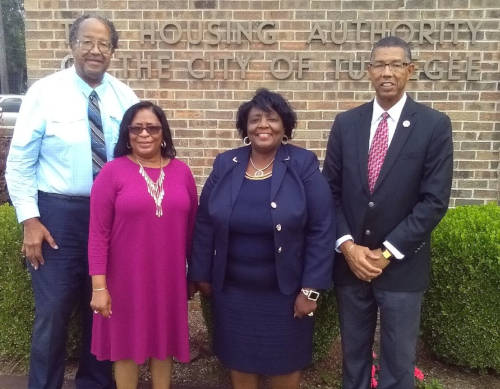
Guy Trammel, a community advocate; Linda Simpson, Executive Director of the Housing Authority of the City of Tuskegee; Sylvia Knight, a staff member of the Housing Authority; and Lawrence Haygood, Mayor of the City of Tuskegee, Alabama
“We don’t believe the traditional telecom model is going to work—where you offer services and people pay for it—so we have an alternative method to provide services to economically stressed communities. You create virtual e-commerce stores through existing organizations, Amazon, Walmart, etc. and you offer the commodities through them,” he says. “The profit then goes to funding the community network. Because you are deploying that network, people who couldn’t purchase things online, now can. And if they do it through those funnels, they give back to the network. They can make more economically sound purchases.”
This allows people who want to contribute to the project to do so without writing a check. Instead, they can make a purchase from that particular store, and some of the money goes back into the system. People from anywhere can buy their goods from this site.
“If you have a dried good or a consumable like toilet paper, you buy that toilet paper from our Amazon site, and then those profits go back in to support the network, that’s the long-term proposition,” he says. “The beauty of that is you don’t have to live in the Housing Authority to buy your toilet paper from our Amazon site.”
In addition to local entrepreneurs getting their brand out there, this allows for the technological pathways to help bring in consumers and money. That money goes back into the project itself and back into the pockets of the business owners taking part in the project. So, now business owners have the infrastructure, the skills to run it, the entrepreneurial insight to make it work for them on a personal level, and a monetary way to maintain the system. But what do they do about some of the assets needed to support this—namely computers and software?
“Most people in an economically stressed community have a phone, but it’s not a sufficient device when you are trying to do homework, or if you are trying to do something on a website where you need a mouse,” Stephens says.
So, they sought permission from the Tuskegee Housing Authority to bring in used equipment and supply those pre-owned machines with free programming languages and software. And they got it.
“My company runs nothing but free software on pre-owned equipment,” Stephens says. “It is not a disadvantage to the end user because it is a powerful combination to mix free software with pre-owned equipment. It becomes a very formidable platform. Let’s democratize the process.”
It can also provide hands-on learning experiences residents wouldn’t otherwise receive. “If the equipment isn’t working, the interns get to open it up and see all the parts and pieces and really understand how it works. We’re able to really teach the inner workings of being a service technician. We’re teaching networking. Technology for tech’s sake isn’t going to work.”
Enabling Partnerships
The original Jesup Agricultural Wagon came to life with a financial grant from Morris Ketchum Jesup, George Washington Carver’s vision, and help from the local community, including Tuskegee Institute students who helped build the wagon itself. That trinity—seed money, innovation, and grassroots support—is also key to launching a successful community network.
Now Projects like the Jesup Cyber Wagon are growing all over the world—thanks to partnerships and initiatives willing to finance these connectivity solutions—with the community at the center of it all, using the Internet to achieve their goals.
The success is that we met the targets of connectivity fast. Communities took advantage of that connectivity right away. It generates employment, supports youth, and grows the Internet locally.”
The communities supported through the partnership between Truist Financial and the Internet Society have been successful in achieving their goals and making a local impact. So much so that both organizations teamed up again in 2022 for round two, granting another million dollars for communities facing accessibility and connectivity problems. The results of Jesup Cyber Wagon and the other empowered communities speak for themselves.
“We can achieve really great things when we work with partners,” Campbell says. “This is a great example of a partnership that has led to faster, affordable, sustainable internet. There is no limit to what we can do with these partnerships.”
Image copyright:
Leading image: Rivers Langley; SaveRivers, CC BY-SA 3.0 via Wikimedia Commons.
All remaining photos are courtesy of Boyd Stephens.